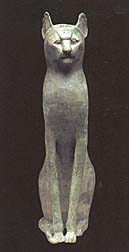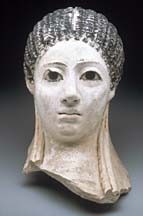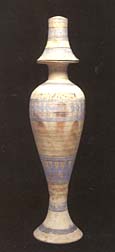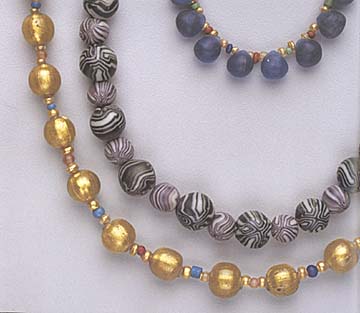Advertisement - Click to support our sponsors.


Honolulu Academy of Arts showcases
By Tim Ryan
a legacy of art, architecture and literature
with its 'Mystery of the Nile' exhibit
Star-BulletinANCIENT Egypt has intrigued people for decades with its wondrous pyramids, tales of golden treasures plundered from pharaohs' elaborate tombs, the otherworldly practice of mummification and mysterious hieroglyphics.
"Egypt is one of the oldest civilizations in the world," said George Ellis, executive director of the Honolulu Academy of Arts. "The people who lived there thousands of years ago left us a wonderful legacy of art, architecture and literature.
"It's a subject which has captured people's imagination for hundreds of years since the earliest excavations," Ellis said. "Remember, the pyramids are among the 10 wonders of the world."
For this reason, a lot of buzz accompanies the Thursday opening of the academy's newest exhibition, "Mystery of the Nile: Treasures From Ancient Egypt." The exhibition is expected to attract 80,000 people.

Crowds are sure to greet the opening, but there's no need rush over all at once. The exhibit will have a four-month run with 140 artifacts, some never before displayed. Included will be sculptures, mummy cases, shrouds and masks, gold jewelry, ornaments, tools and architectural fragments.
ON EXHIBIT
What: "Mystery of the Nile: Treasures from Ancient Egypt"
Where: Honolulu Academy of Arts, 900 S. Beretania St.
When: Thursday through July 30. Hours are 10 a.m. to 4:30 p.m. Tuesdays through Saturdays and 1 to 5 p.m. Sundays. Guided tours offered 11 a.m. Tuesdays through Saturdays and 1:15 p.m. Sundays.
Cost: Adults pay $12 on weekdays, $15 on weekends; $5 for children 6-12; 5 and under free. Member audio tours are $3.
Tickets: Available at the academy main entrance, all Ticket Plus outlets, Foodland and Sack 'n Save. Advance ticket purchases recommended.
Order by phone: Ticket Plus Hotline at 526-4400
Call: 532-8700
Recorded information: 532-8701
Parking: Lot behind Academy Art Center, 1111 Victoria St., $1 with validation
Bringing the show to Hawaii has been "an arduous, expensive, logistically difficult process," Ellis said. After three years of planning, budgeting and fund-raising, the show goes on even though it is unlikely the museum will profit. At best, the academy hopes to break even.
"These exhibits have a history of success, but we didn't do it firstly to make money," Ellis said. "We know you can't bring something this expensive and elaborate to Hawaii unless there's an audience. But we know there are population limitations here and only so many people will have access to the academy."

While mainland museums draw attendance from the suburbs, that isn't possible on Oahu, Ellis said. In Dallas, more than 120,000 visitors viewed the show."We won't recoup the costs, but we'll take a loss to benefit the community," he said. "We have an exhibition budget for these situations and we have charitable sponsors."
Measuring the success of the exhibit in Honolulu is simple, Ellis said.
"If people leave knowing more about ancient Egypt and its remarkable civilization than before they arrived, we've accomplished our mission."
There are a variety of programs being offered toward this end, such as a series of lectures and films, keiki art activities, a children's exhibition "Tales from the Tomb," and specialized docent training for tour guides and teachers.

The collection being displayed spans 5,000 years of Egyptian cultural history. Guest curator Egyptologist David P. Silverman said the exhibit is more spectacular than the widely popular "Treasures of Tutankhamen" exhibit he helped put together in the late 1970s.Silverman edited the full-color, 342-page book "Searching for Ancient Egypt: Art, Architecture, and Artifacts," that accompanies the exhibit and will be available for purchase in the Academy Shop, at $37.50 softbound and $60 hardbound.
"Mystery's" treasures enable viewers to learn more about the historical continuity of Egyptian society and art, Ellis said. The exhibition compares Egypt to its African neighbors like the Sudan, which has shared a similar culture throughout the ages, he said.
The civilization of Nubia, another Nile-based culture south of Egypt, is represented in the exhibition.

The exhibition is especially important to researchers since the greatest portion of the material was obtained through scientific excavation, Ellis said.The controlled excavation allows archaeologists to know where the objects come from, confirm their authenticity and ascertain dates of origin. Silverman said acquiring objects largely through excavation is no longer possible for institutions from outside a given country because most countries of origin do not allow those objects recovered to be exported.

Ellis, who has been at the academy for 18 years, ranks "Mystery" on par with the Xian exhibition five years ago. That show, of life-size warrior statues and treasures unearthed in China, attracted about 80,000 people, he said.The exhibition artifacts, some 6-feet tall and weighing as much as 2,500, pounds, were shipped to Hawaii by air in two 40-foot containers. The items are too fragile and valuable to send by ship, Ellis said.

To appreciate "Mystery," Ellis recommends viewers read the explanatory panels in the academy's central courtyard before seeing the exhibit. He also recommends the audio guide which "brings the objects to life."The self-directed, random-access CD-ROM audio tour is in both adult and family/children's versions to help listeners appreciate what the art on display meant to the people who made and used it, Ellis said. The audio tour, played on compact disc, allows visitors to roam the exhibition while randomly accessing stops on the audio tour in any order they choose.

The Egyptian concept of afterlife also will be explored through statue-like objects used to house the spirit of the deceased, and a presentation of materials used in mummification and burial, including jars that held the internal organs of the deceased. Other pieces include amulets, ceramics, stone vessels and cosmetic tools used in life and buried with their owners.The exhibition is not only devoted to royalty, but to the elite classes of people employed in the artistic or commercial arena. In this way the display will offer insights into Egyptian life and societal development, Ellis said.
The traveling exhibition also has been presented at the Denver Art Museum and the Seattle Art Museum and travels to Miami after Honolulu.
Click for online
calendars and events.